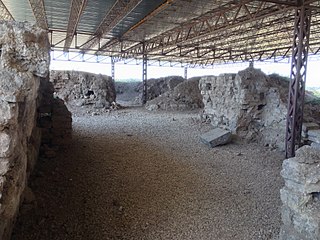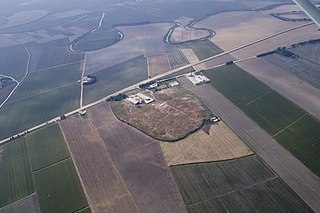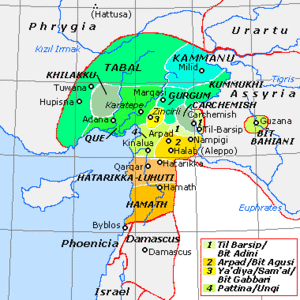
The Hurrians were a people who inhabited the Ancient Near East during the Bronze Age. They spoke the Hurrian language, and lived throughout northern Syria, upper Mesopotamia and southeastern Anatolia.
Ugarit was an ancient port city in northern Syria about 10 kilometers north of modern Latakia. At its height it ruled an area roughly equivalent to the modern Latakia Governorate. It was discovered by accident in 1928 with the Ugaritic texts. Its ruins are often called Ras Shamra after the headland where they lie.

Carchemish, also spelled Karkemish, was an important ancient capital in the northern part of the region of Syria. At times during its history the city was independent, but it was also part of the Mitanni, Hittite and Neo-Assyrian Empires. Today it is on the frontier between Turkey and Syria.

Alalakh is an ancient archaeological site approximately 20 kilometres (12 mi) northeast of Antakya in what is now Turkey's Hatay Province. It flourished, as an urban settlement, in the Middle and Late Bronze Age, c. 2000-1200 BC. The city contained palaces, temples, private houses and fortifications. The remains of Alalakh have formed an extensive mound covering around 22 hectares. In Late Bronze Age, Alalakh was the capital of the local kingdom of Mukiš.

Tell Ta'yinat is a low-lying ancient tell on the east bank at the bend of the Orontes River where it flows through the Amuq valley, in the Hatay province of southeastern Turkey about 25 kilometers south east of Antakya, and lies near Tell Atchana, the site of the ancient city of Alalakh. Tell Ta'yinat has been proposed as the site of Alalaḫu, inhabited in late 3rd millennium BC, mentioned in Ebla's Palace G archive; and in later times as Kinalua, the capital city of an Iron Age Neo-Hittite kingdom. Among the findings are an Iron Age temple and several 1st millennium BC cuneiform tablets.

Tell Barri is a tell, or archaeological settlement mound, in north-eastern Syria in the Al-Hasakah Governorate. Its ancient name was Kahat as proven by a threshold found on the south-western slope of the mound. Tell Barri is situated along the Wadi Jaghjagh, a tributary of the Khabur River.
Tarḫuntašša was a Bronze Age city in south-central Anatolia mentioned in contemporary documents. Its location is unknown. The city was the capital of the Hittite Empire for a time and later became a regional power in its own right. The kingdom controlled by the city is known by the same name and its approximate borders are known from texts.

Alacahöyük or Alaca Höyük is the site of a Neolithic and Hittite settlement and is an important archaeological site. It is situated near the village of Alacahüyük in the Alaca District of Çorum Province, Turkey, northeast of Boğazkale, where the ancient capital city Hattusa of the Hittite Empire was situated. Its Hittite name is unknown: connections with Arinna, Tawiniya, and Zippalanda have all been suggested.
Beycesultan is an archaeological site in western Anatolia, located about 5 km southwest of the modern-day city of Çivril in the Denizli Province of Turkey. It lies in a bend of an old tributary of Büyük Menderes River.

The ancient Near East was the home of early civilizations within a region roughly corresponding to the modern Middle East: Mesopotamia, ancient Egypt, ancient Persia, Anatolia and the Armenian highlands, the Levant and the Arabian Peninsula. The ancient Near East is studied in the fields of ancient Near East studies, Near Eastern archaeology, and ancient history.
Lorenzo Nigro is an Italian archaeologist, novelist and watercolorist. He is Full Professor of Near Eastern Archaeology in the Faculty of Letters and Philosophy at Sapienza University of Rome. He directs three main archaeological expeditions: at Jericho in Palestine, with the Ministry of Tourism and Antiquities, at the Early Bronze Age fortified city, previously unknown, of Khirbet al-Batrawy in the Hashemite Kingdom of Jordan, and at Motya, a Phoenician city in Western Sicily, while also acting as co-director of the Institut national du patrimoine-Sapienza University of Rome Expedition to Carthage in Tunisia. Since 2015 he started the archaeological exploration and protection activities, again in cooperation with the Palestinian Ministry of Tourism and Antiquities, in the Bronze and Iron Age necropolises of the Bethlehem urban area and at the site of Tell esh-Sheikh Abu Zarad, ancient Tappuah. In all these excavations he has been the protagonist of several important discoveries, from the reconstruction of the Bronze Age city at Jericho, to the Temple of the Kothon at Motya, to the entire unknown city of Batrawy with its magnificent fortifications and the Palace of the Copper Axes, and the Broad Room temple. At Motya it has uncovered at least four temples and detailed a prehistoric stratigraphy at the foot of the acropolis showing that the island in Sicily was occupied and known to Mediterranean sailormen since the beginning of the 2nd millennium BC.

Palistin, was an early Syro-Hittite kingdom located in what is now northwestern Syria and the southeastern Turkish province of Hatay. Its existence was confirmed by the discovery of several inscriptions mentioning Taita, king of Palistin.
Tell Judaidah is an archaeological site in south-eastern Turkey, in the Hatay province. It is one of the largest excavated ancient sites in the Amuq valley, in the plain of Antioch. Settlement at this site ranges from the Neolithic through the Byzantine Period.

Kilise Tepe is a mound in Mersin Province, Turkey, just west of the Göksu River, lying 20 kilometers from Mut and 145 kilometers from Mersin. It was initially known as Maltepe which is actually the name of a site on the other bank of the river about four kilometers to the west. The original name of the mound is not known and Kilise Tepe in Turkish means "church-hill" referring to a church ruin. The site is thought to have been part of the land of Tarḫuntašša, formed when Muwatalli II moved the Hittite capital.

Niğde Archaeological Museum is located in the centre of the Turkish provincial capital, Niğde between Dışarı Cami Sokak and Öğretmenler Caddesi. It contains objects found at sites in the surrounding area, including the tell of Köşk Höyük and the Graeco-Roman city of Tyana, both in the nearby town of Kemerhisar.
Norşuntepe is a tell, or archaeological settlement mound, in Elazığ Province (Turkey). The site was occupied between the Chalcolithic and Iron Age and is now partially submerged by Lake Keban. It was excavated between 1968 and 1974.
Tell Hadidi, ancient Azu, is an ancient Near East archaeological site in Syria about 30 kilometers north of Emar and 5 kilometers north of Ekalte. It lies on the west bank of the Euphrates River on the opposite bank from Tell es-Sweyhat. It is thought to be a paired city with Tell es-Sweyhat controlling a Euphrates river crossing. There are prominent hollow ways between the site and Tell es-Sweyhat, Tell Othman, and Tell Jouweif. The site was occupied from the Early Bronze Age period to the Late Bronze Age and again to a lesser extent in Roman times. It was one of several rescue excavations sparked by the construction of the Tabqa Dam and the resulting Lake Assad. The town's primary god was Dagan.
Usakli Hoyuk is located at Büyüktaslik Village in the district of Sorgun, Yozgat Province, Turkey, to the north of Mount Kerkenes. It was an important Hittite city that flourished in the second millennium BC, and was identified as a possible location of the ancient city of Zippalanda, the centre of the cult of the Storm God.
Çadır Höyük is an important ancient settlement and archaeological site in Yozgat Province, Turkey 16 kilometers south of Sorgun. It lies around 70 kilometers from the Hittite capital of Hattuša. The artificial mound contains the remains of some 6,000 years of human settlement ranging from the Middle Chalcolithic era to the Byzantine period. The mound reaches the height of 32 metres above the valley plain. Recent excavators of Cadir Hoyuk have identified this site tentatively with the Hittite city of Zippalanda.
Tell Yelkhi, is an ancient Near East archaeological site in Diyala Governorate (Iraq). It was examined as part of the Hamrin Dam salvage excavation before it flooded. Other sites a part of that rescue excavation included, Me-Turan, Tell Gubah, Tell Songor, Tellul Hamediyat, Tell Rubeidheh, Tell Madhur, Tell Imlihiye, Tell Rashid, Tell Saadiya and Tell Abada. Some of these sites, including Tell Yelkhi, periodically emerge from the water. The site of Tell Yelhi was settled in the early 3rd millennium BC and occupation continued through the Kassite period late in the 2nd millennium BC. It's name in ancient times is not yet known though Awalki has been suggested.












